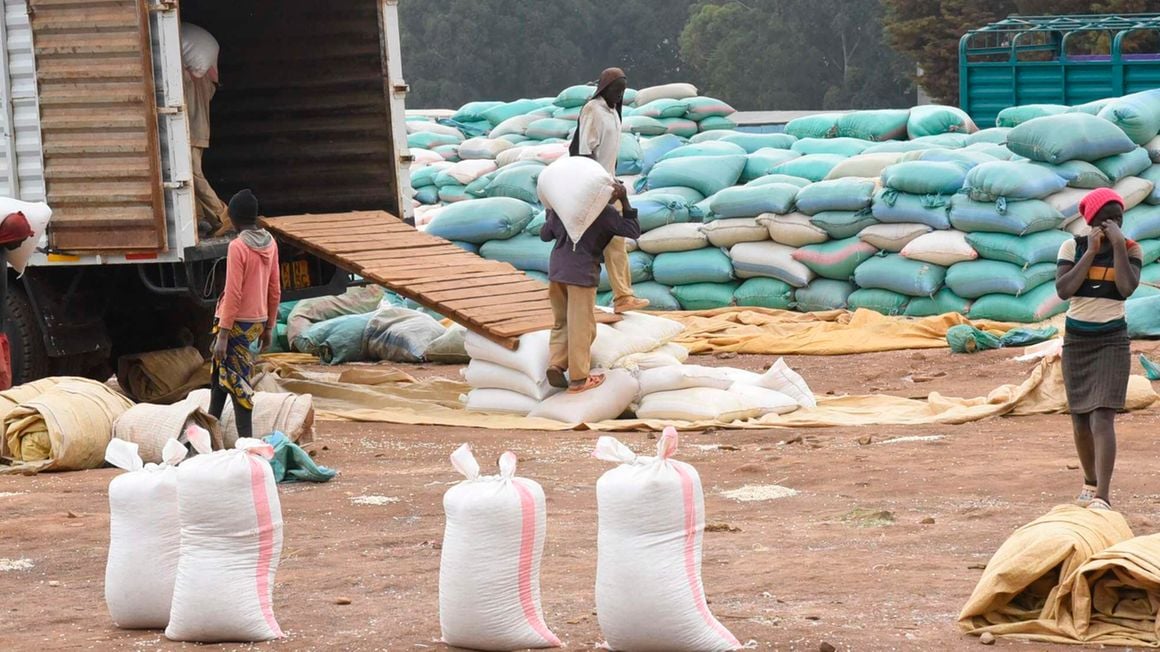
Farmers during drying of maize near Kipchoge Keino Stadium in Eldoret town, Uasin Gishu County on December 21, 2022. PHOTO | JARED NYATAYA | NMG
The Agriculture sector is now contributing less than one-fifth of Kenya's economic growth following four consecutive quarters of decline.
Data from the third quarter gross domestic product report by the Kenya National Bureau of Statistics (KNBS) shows the sector’s contribution to Gross Domestic Product (GDP) was cut to 19.9 percent from 23.4 percent in the quarter to March.
Across the same period, the sector contracted by 0.7. 1.4 and 0.6 percent respectively in the first three quarters of 2022, marking the fourth consecutive quarter of contraction or an equivalent year of decline from September 2021.
The sector last contributed less than one-fifth of GDP in the quarter that ended September 2021 or an equivalent 19.8 percent of GDP.
On an annualized basis, the agriculture sector has consistently stood at more than one-fifth of GDP or 20 percent and peaked recently at 22.6 percent of the economy in 2020 according to KNBS data.
A prolonged drought stretching back to last year is attributable to the declining significance of Kenya’s largest economic sector with the peril disrupting both productivity and agricultural exports.
“The slowdown in the performance of the sector was mainly attributed to unfavourable weather conditions that prevailed in the first three quarters of 2022. The decline was reflected in vegetable exports and milk intake by processors that declined by 26.1 percent and 10.7 percent respectively during the quarter under review,” KNBS stated.
“Vegetable exports declined from 18,685 metric tonnes in the third quarter of 2021 to 13,807 metric tonnes in the quarter under review. The amount of milk delivered to processors reduced to 186.96 million litres in the third quarter of 2022 from 209.28 million litres recorded in the same quarter of 2021.”
Agriculture has this year taken a hit once again from a familiar foe with erratic and poorly distributed long rains and inadequate short rains leading to the sector’s first annual decline in four years across 2021.
The sector registered a 0.2 percent annualized contraction to end a three-year growth expansion which began after a 1.3 percent decline in 2017.
READ: Equity eyes new farming methods to fight drought
The high-grossing sector for the Kenyan economy expanded by 5.7, 2.7 and 4.6 percent respectively between 2018 and 2020.
In 2021, maize production had declined by 5.4 million bags to 36.7 million bags while coffee production was down six percent at 34,500 tons in the 2020/21 crop year.
Tea production had meanwhile declined by 5.6 percent from 569,500 tons in 2020 to 537,800 tons in 2021 on unfavourable weather conditions.
In the quarter to September 2022, the contraction of the agriculture sector was partly offset by the improved production and export of fruits, coffee and cane.
Fruit exports for instance grew by 53.9 percent while coffee production was up by more than twofold to stand at 9,900 metric tons.
Cane deliveries meanwhile improved by six percent in the third quarter to 648.2 metric tons.
Despite the shallow decline, a contraction in the agriculture sector carries with it significant ramifications for employment creation and household income has given the industry’s significance to earnings and job creation.
For instance, the sector contributed to 295,300 modern sector jobs in the private sector across 2021 according to KNBS statistics while the sector employed 41,900 persons in the public sector in the same period.
READ: Innovators step up the fight against food insecurity
The contribution to GDP by other sectors in the three months to September remained largely unchanged with transport & storage, real estate, wholesale & retail, manufacturing and construction contributing to 12.2, 8.9, 7.9, 7.5 and 7.3 percent.
→ kmuiruri@ke.nationmedia.com

No comments:
Post a Comment